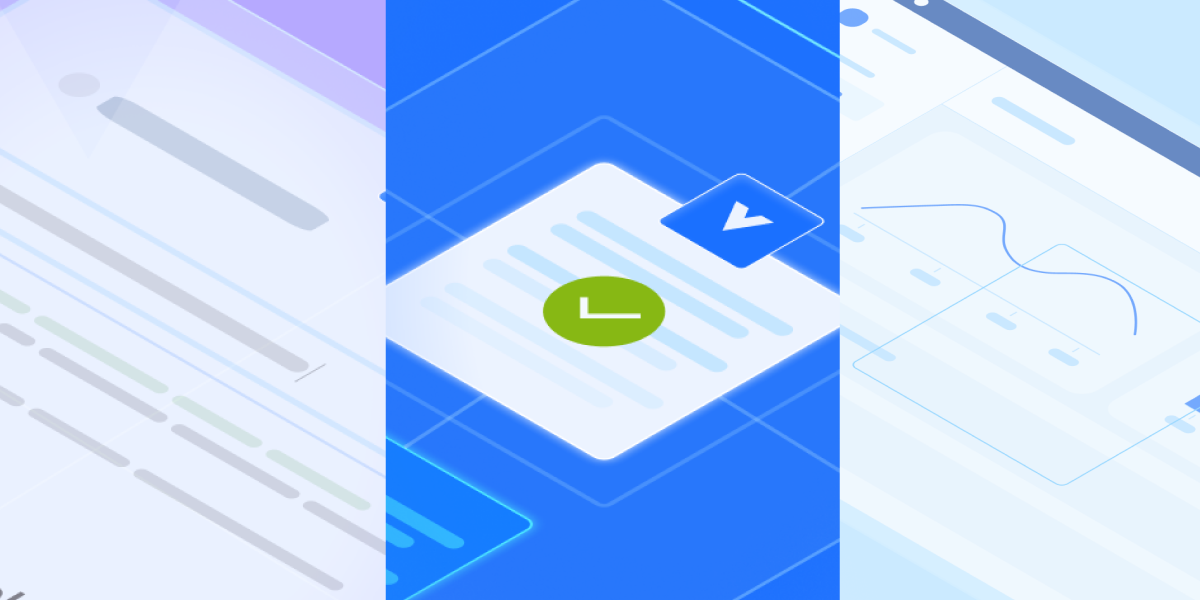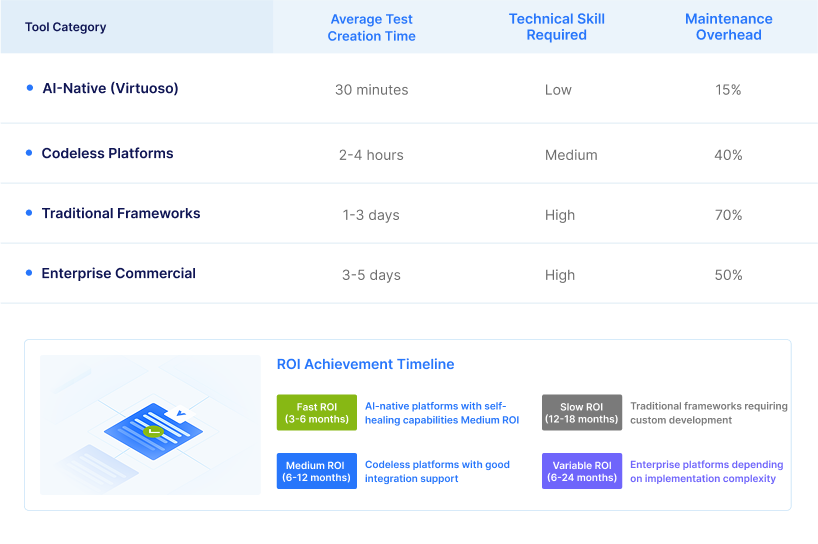
See Virtuoso QA in Action - Try Interactive Demo

Comprehensive guide to the best test automation tools for enterprises. Compare AI-powered, codeless, and traditional platforms. Expert analysis, ROI metrics, and implementation strategies included.
Choosing the right test automation tools can make or break your software delivery pipeline. With over 200+ testing platforms in the market and enterprise software complexity increasing by 40% annually, the stakes have never been higher.
This comprehensive guide analyzes the leading test automation tools based on real-world enterprise implementations, performance benchmarks, and ROI data from organizations managing complex software ecosystems.
Key Finding: Traditional script-based tools are being rapidly displaced by AI-powered testing platforms that deliver 10x faster implementation and 85% lower maintenance overhead.
Market Leaders by Category:
Bottom Line: Organizations achieving digital transformation success are standardizing on AI test automation tools that combine natural language programming, self-healing capabilities, and enterprise-scale integration.
What They Are: Platforms using machine learning, natural language processing, and computer vision to create, execute, and maintain tests autonomously.
Key Capabilities:
Best For: Enterprises seeking rapid automation scale-up with minimal technical debt.
What They Are: Code-based frameworks requiring programming expertise for test creation and maintenance.
Key Capabilities:
Best For: Organizations with dedicated automation engineering teams and custom framework requirements.
What They Are: Visual testing tools enabling test creation without programming through drag-and-drop interfaces and keyword-driven approaches.
Key Capabilities:
Best For: Teams transitioning from manual testing seeking immediate automation capabilities.
Strengths:
Performance Metrics:
Best Use Cases: Complex enterprise applications, regulatory compliance testing, continuous delivery pipelines
Pricing Model: Enterprise subscription with unlimited test execution
Learn more about Virtuoso's AI-native testing platform →
Strengths:
Limitations:
Best Use Cases: Mid-size development teams with some technical expertise
Strengths:
Limitations:
Best Use Cases: SaaS applications and web-focused testing scenarios
Strengths:
Limitations:
Performance Metrics:
Best Use Cases: Organizations with dedicated automation engineers and custom testing requirements
Strengths:
Limitations:
Best Use Cases: JavaScript-heavy applications with developer-led testing teams
Strengths:
Limitations:
Best Use Cases: Modern web applications requiring comprehensive browser coverage
Strengths:
Limitations:
Best Use Cases: Large SAP implementations and highly regulated industries
Strengths:
Limitations:
Best Use Cases: Legacy system testing and Windows-heavy environments
AI and Machine Learning Features
Integration and Scalability
Enterprise Requirements
Direct Costs
Hidden Costs
ROI Calculation Framework
Total Benefits = (Test Execution Savings + Maintenance Reduction + Quality Improvements + Faster Release Cycles)
Total Costs = (Licensing + Infrastructure + Training + Maintenance + Opportunity Costs)
ROI = (Total Benefits - Total Costs) / Total Costs × 100Technical Skill Requirements
User Experience and Adoption

Fast ROI (3-6 months): AI-native platforms with self-healing capabilities Medium ROI (6-12 months): Codeless platforms with good integration support
Slow ROI (12-18 months): Traditional frameworks requiring custom development Variable ROI (6-24 months): Enterprise platforms depending on implementation complexity
High Success Organizations (>80% adoption rate):
Low Success Organizations (<40% adoption rate):
Technical Requirements Analysis
Organizational Readiness Evaluation
Proof of Concept Development
Stakeholder Feedback Collection
Gradual Rollout Strategy
Center of Excellence Establishment
Artificial Intelligence Evolution
Cloud-Native Architecture
DevOps Integration Deepening
Near-term (6-12 months)
Medium-term (1-2 years)
Long-term (2-5 years)
Strategic Considerations
Investment Justification
Technical Decision Criteria
Operational Excellence Factors
The test automation tools landscape has fundamentally shifted toward AI-powered platforms that eliminate traditional barriers to automation adoption. Organizations achieving digital transformation success are standardizing on tools that combine intelligent automation, natural language programming, and enterprise-scale integration capabilities.
Key Recommendations:
For Large Enterprises: Prioritize AI-native platforms like Virtuoso that offer comprehensive automation capabilities with minimal technical debt and maximum ROI potential.
For Growing Organizations: Consider codeless test automation tools that enable rapid scaling while building internal automation expertise and capabilities.
For Developer-Centric Teams: Evaluate modern framework-based tools like Playwright or Cypress that align with existing technical skills and development workflows.
For Regulated Industries: Focus on enterprise platforms offering built-in compliance features, extensive support, and proven track records in similar environments.
The future belongs to organizations that choose automation platforms as strategic enablers rather than tactical tools. By selecting AI-powered test automation tools that grow with your business and adapt to changing requirements, you're investing in sustainable competitive advantage rather than temporary efficiency gains.
For teams new to automation, AI-powered platforms like Virtuoso offer the fastest path to success with natural language test creation and self-healing capabilities. Codeless tools like Katalon or TestComplete provide visual interfaces that don't require programming skills, while traditional frameworks like Selenium require significant technical investment but offer maximum flexibility.
Calculate ROI by comparing total benefits (test execution savings, maintenance reduction, quality improvements, faster releases) against total costs (licensing, infrastructure, training, maintenance, opportunity costs). AI-native tools typically achieve positive ROI within 3-6 months, while traditional frameworks may require 12-18 months due to higher implementation and maintenance costs.
AI-powered tools use machine learning for intelligent object identification, self-healing capabilities, and natural language test creation, requiring minimal maintenance. Traditional tools rely on scripted automation requiring programming expertise and extensive maintenance when applications change. AI tools typically deliver 10x faster implementation and 85% lower maintenance overhead.
Open source tools like Selenium offer lower licensing costs but require significant technical investment for framework development and maintenance. Commercial platforms provide comprehensive features, support, and faster implementation but involve licensing costs. AI-powered commercial tools often deliver better ROI despite higher upfront costs due to reduced maintenance and faster implementation.
Successful adoption requires gradual rollout strategy starting with pilot projects, comprehensive training for different team roles, executive sponsorship for change management, and clear success metrics. Choose tools that match your team's technical capabilities and provide adequate support during implementation. Establish a center of excellence for best practices and continuous improvement.
Industry Resources and Further Reading:

Try Virtuoso QA in Action
See how Virtuoso QA transforms plain English into fully executable tests within seconds.